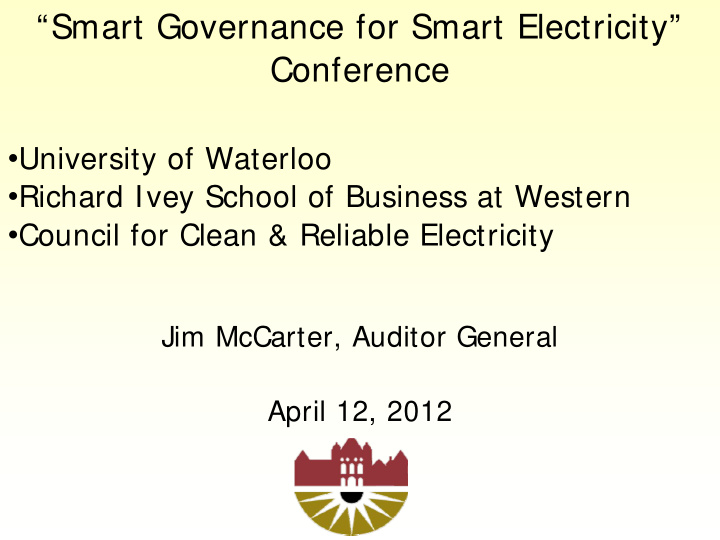



“Smart Governance for Smart Electricity” Conference • University of Waterloo • Richard Ivey School of Business at Western • Council for Clean & Reliable Electricity Jim McCarter, Auditor General April 12, 2012
What I’d Like to Discuss Some background on the Ontario Auditor General’s Office 2011 electricity related audits Regulatory Oversight Stranded Debt & the Debt Retirement Charge Renewable Energy Initiatives Some thoughts for your panel discussions Some time for questions 1
What Do We do? Act as Legislature’s watchdog in helping them ensure taxpayer funds are prudently spent and encourage improvements in the way public services are delivered by government ministries, agencies, and the broader public sector. VFM Audit - focus is on how well a government program, broader public sector entity or service area is operating but we do not question government policy. Traditional auditor role - provide assurance that financial statements are fairly presented . 2
Size of Office Office’s annual estimates approved by the all party Board of Internal Economy In comparison to several other larger audit offices: Population Office Budget $ Staff Federal 33.0M 80.6M 681 Quebec 7.6M 26.0M 244 Alberta 3.2M 22.0M 131 Ontario 12.5M 16.2M 117 BC 4.2M 15.2M 119 3
What Types of Audits does the Office do? "Special" VFM audits 6% Province's financial statements 4% Value for money audits Agency F/S audits Province's F/S audit Crown Agency "Special" VFM audits financial statements 25% Value for money audits 65% 4
Reporting our Findings The Auditor General's Annual Report is tabled in the Legislative Assembly typically in late November or early December. The media requests that we hold a pre-release lock-up and a formal press conference. Sometimes in-year ‘special’ audit such as Ornge. From a Ministry’s perspective, it is often their appearance before the Legislature's Standing Committee on Public Accounts that is of most “interest”. 5
Standing Committee on Public Accounts (PAC) Standing Orders of the Legislature creates an all- party Standing Committee on Public Accounts. Current committee: 4 Liberals, 3 Conservatives and 2 New Democratic Party. Opposition chair usually votes with government (by precedent). PAC focuses almost entirely on value-for-money audits of government programs versus accounting or financial audit issues. Federal government and 10 provinces all have PAC’s but Ontario one of the most active and typically meets 20-25 times a year. 6
Electricity Regulatory Oversight Reviewed role of the Ontario Energy Board in protecting consumer interests and promoting reliable, sustainable electricity at a reasonable cost. Objective also to provide information to Legislature and the public. Average consumer electricity prices ↑ 65% since 1999 restructuring and expected ↑ 46% next 5 years 7
Some Good News OEB has undertaken some good initiatives to educate consumers. On-line bill calculator. Staff provides Board members with useful analysis to assist in assessing often complex rate submissions. Well structured performance reporting process (although more results-based vs. process-oriented could improve this). 8
Key Issues Raised OEB jurisdiction only covers about one-half of the total $ on typical bill. No oversight over ‘debt retirement charge’. Of $900 million cost to administer & operate electricity market, OEB oversees only $190 million. Rate application process costly for small and mid-size utilities. ‘Intervenors’ – costs and benefits Oversight of electricity retailers 9
Stranded Debt & the Debt Retirement Charge Explain stranded debt, residual stranded debt and the “so what” Electricity Act – stranded debt and the debt retirement charge sections were, in our opinion, somewhat open to interpretation Comprehensive legal opinion on: Determine outstanding amount ‘from time to time’ Make determination public What residual stranded debt legally means When debt retirement charge to end 10
Debt Retirement Charge $7.8 billion original residual stranded debt DRC collected for a decade and more than $8 billion has been collected Residual stranded debt calculation – Act would allow different interpretations such as treat like a mortgage – some DRC pays interest and some principal pay down From ‘time to time’ Minister must determine amount of residual stranded debt – a decade has passed: time’s up! 11
Renewable Energy Initiatives Auditor’s Observations Background – Green Energy Legislation and powers provided to Minister Allowed wind and solar projects to be expedited and renewable power ↑ significantly by 2018 Coal-fixed generation shut down by 2015 12
Renewable Energy Initiatives Auditor’s Observations Wind and solar intermittent and will require almost 50% back-up power, typically gas-fired generation. Information on cost of fast-tracking — expensive power Average bill ↑ 7.9% annually next 5 years OPA designated as province’s “energy planner” but OPA’s $10.7 million plan suspended and replaced by Ministry of Energy’s plan. 13
Renewable Energy Initiatives Auditor’s Observations Normal ‘business case’ analyses not done to usual extent especially given multi-billion dollar cost. Number of price “adjustments” to reduce costs possible but policy decision that price stability more important Little formal business case analysis done supporting Korean consortium contract Better analysis of job creation data published given experience in other jurisdictions 14
Standing Committee on Public Accounts (PAC) With number of Ornge hearings scheduled and late start due to election, PAC likely have time to hold only 6 hearings on 2011 Auditor’s Annual Report. Of the 14 2011 value-for-money audits and 14 follow-up sections of 2009 VFM audits to chose from, PAC has selected 2 of the 3 electricity audits for hearings OEB Regulatory Oversight Renewable Energy Initiatives 15
3 Questions to Mull Over Why is the OEB needed at all – just let the government of the day set electricity rates just as they set the various tax rates or should the OEB have jurisdiction over all charges on electricity bills? Do you agree that the Auditor reached the right conclusion — “ times up ” with respect to informing the public where things stand on the debt retirement charge? The Auditor’s Office does not question government policy but rather audits whether such policy has been implemented cost-effectively. But does an audit of Renewal Energy Initiatives cross-the-line & indirectly question the renewable policy decision? 16
17 Any Questions? Thank you and
Recommend
More recommend